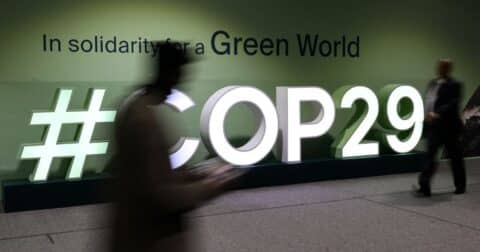Solutions
Urban Foragers Are Mapping Edible Plants Around the World
Climate•5 min read
Reported
Sticking points to significant reform, explained.


Words by Grace Hussain
The United Nations’ annual climate conference — COP29 — has come to an end. More than 60,000 delegates from almost 200 countries came together, largely to discuss how to finance efforts to stop the climate crisis. For one day, they also talked about food systems, a major contributor of greenhouse gas emissions.
That day followed in the footsteps of last year’s conference, COP28, which centered around food reform. There, delegates agreed that addressing emissions from food systems is necessary in order to meet climate goals. But neither during COP28 or COP29 did delegates walk away with the intent of reducing herd sizes, or binding commitments to shifting dietary patterns. Instead, COP28 upheld livestock as part of the solution to the climate crisis, despite animal agriculture being responsible for at least 16.5 percent of greenhouse gas emissions.
On November 20, U.S. Farmers and Ranchers in Action (USFRA) and the Council for Agricultural Science and Technology (CAST) presented their new report at this year’s climate conference, perpetuating the idea that agriculture, including livestock, is a climate solution. The report suggests that the technology to shift the U.S. agriculture industry to a carbon sink could be implemented in the near future.
“We wanted to look at what’s near term, five, maybe 10 years at most,” Chuck Rice, a distinguished professor of agronomy working at Kansas State University, and one of the report’s authors, said in a webinar launch event.
“We can reduce [greenhouse gasses]. We can improve soil health while also increasing farmer profitability,” USFRA chief executive officer Kevin Burkum said during the webinar. Others are more skeptical about the practicalities of the report’s suggestions, however.
“There are some big issues with the mitigation estimates that make them high,” Richard Waite, who leads the World Resources Institute’s agricultural initiatives, told Sentient in an email. He points specifically to the considerable role the report’s authors expect soil to play by sequestering carbon.
“Our research has shown that these regenerative practices, while good for soil health, water retention, water quality and building resilience, are unlikely to provide many [greenhouse gas] mitigation benefits for various reasons,” Waite says. Part of the problem, he argues, is that the report’s authors extrapolate research findings over hundreds of millions of acres of land, an approach that “will give big mitigation estimates, but says nothing about how feasible any of this is.”
The report claims that the pasture and rangeland that cattle occupy absorbs carbon. Soil can act as a major sequester, but agricultural management isn’t necessarily helping with that process. Instead, transitioning land into pastureland can reduce its carbon capturing capacity.
“There are mitigation options that remain unexplored, including…restoration of some agricultural land to natural ecosystems,” Waite points out. Rewilding may be one of the best strategies for encouraging land to store carbon.
“Beef production provides economic value to rangelands, keeping the ecosystem services intact,” reads CAST’s report. While ranchers may be making money off cattle, the government — and by extension taxpayers — are losing money.
Ranchers lease 155 million acres of land for grazing livestock from the Bureau of Land Management. Every year, the cost of managing those leases exceeds what ranchers pay by more than $100 million. Part of the issue is that the cost to ranchers per animal hasn’t kept up with inflation. The last time that fees changed was when President Trump lowered them in 2019 from $1.41 to $1.35 per animal per month. Had the cost to ranchers kept up with inflation, the per-animal cost would have hit $7.46 in 2022.
For Waite, the biggest sticking point is the adoption rates the report relies upon. The report calculates impact at two levels of adoption — medium (50 percent) and aggressive (75 percent) — across all agricultural lands in the United States. “This study makes the net zero pathway seem much easier than it will actually be because it overestimates adoption rates,” says Waite.
While it’s true that across the country farmers are implementing various sustainable practices on their farms, they’re not applying those methods to their entire operation. Row crop producers — including those cranking out soy and corn, which are core components of animal feed — are lagging behind the farmers growing specialty crops like fruits and vegetables.
The technologies and practices proposed in the report can cut greenhouse gas emissions, and should be viewed as part of the solution to agriculture’s contributions to climate change, says Waite.
However, “the report overestimates what mitigation is possible, and certainly within a 5-10 year period,” Waite says. Instead, they should be pursued alongside “working to change our food consumption patterns in the United States.” He proposes 2050 as a more realistic goal for “achieving a scenario where we have greatly reduced agricultural production emissions and are able to restore some natural areas, thereby ‘offsetting’ those remaining, much lower agricultural emissions and getting to ‘net zero.’”
Sentient reached out to CAST for comment. The email was directed to USFRA, and Kevin Burkum — the organization’s executive director — pointed us back toward the report, its interpretive summary and the webinar, without providing further comment.